A proposed simplified scorecard for the linear descriptive evaluation of dairy characters of female camels (Camelus dromedarius) of the Majaheem breed
- Bulaida Farms, Fujairah, United Arab Emirates
The camel (Camelus dromedarius) holds significant importance as a valuable livestock species for milk production. Consequently, there is an increasing need to enhance attitudes toward increasing camel milk production by selectively breeding camels with desirable milk production attributes. The Majaheem camels have gained recognition for their favorable milk production traits. However, there is currently a lack of rational and modern tools to aid in the evaluation of Majaheem camels, specifically in terms of their milk production capabilities. To address this deficiency and provide guidance to camel breeders for the effective evaluation and selection of superior milk-producing Majaheem camels, a breed linear scorecard is proposed in line with that adopted for Holstein–Friesian milking cattle. However, the scorecard has been simplified and adapted to the phenotypic characteristics of the Majaheem camel breed.
Introduction
The dromedary or camel (Camelus dromedarius) is a livestock species of increasing importance, with numbers now exceeding 35 million (FAOSTAT, 2020; Faye, 2020). Camels are multipurpose livestock animals providing both milk and meat, which are also utilized as work or riding animals in a large number of African and Asian countries (Wilson, 1984; Hjort, 1988; Schwartz and Dioli, 1992; Evans et al., 1995; Cherifi et al., 2013; Dioli, 2014; Derradji et al., 2015; Dioli, 2016; Gherissi et al., 2020; Meghelli et al., 2020; Dich et al., 2022; Gaouar and Ciani, 2023). Similar uses for camels have been adopted in many countries in the Arabian Peninsula (Musa et al., 2000; Al Ani, 2004; Breulmann et al., 2007; Abdallah and Faye, 2013), where camels are also used as racing animals (Khalaf, 1999; James, 2020). In addition, in recent years, there has been a growing trend of utilizing camels for the purpose of intensive milk production (Nagy et al., 2013; Nagy and Juhasz, 2016; Nagy et al., 2022; El-Hanafy et al., 2023).
No camel breed has been selected specifically and exclusively for its milk or meat phenotypes because those people following a nomadic lifestyle require a multipurpose animal. However, in the Arabian Peninsula, and in some countries in Africa, there are several camel breeds, identified by their different coat color (Cherifi et al., 2013; Holl et al., 2017; Alaskar et al., 2020; Alaskar et al., 2021), with good milk production qualities. Among Arabian Peninsula breeds, the Majaheem camel breed, the animals of which are large with a uniform coat ranging in color from dark brown to nearly black, is one of the breeds most used for milk production, particularly in the United Arab Emirates and in other Gulf countries (El-Hanafy et al., 2023; Alhadrami and Faye, 2016; Al-Atiyat et al., 2016). However, despite the widespread distribution of the Majaheem breed and their well-known milk production traits, there is a lack of modern tools available to evaluate their milking characteristics. Currently, selection criteria rely on personal observations or vague general statements (Dioli, 2016). To address this issue and facilitate the rational evaluation and selection of a modern Majaheem camel milk breed, this article proposes the use of a linear evaluation tool. This tool is based on the linear type of assessment utilized for the Holstein–Friesian cattle breed but has been simplified and adapted to suit the unique phenotypic traits of the Majaheem camels.
Materials and methods
The methodology employed in this study is based on the same approach used to develop the linear score evaluation method for Holstein–Friesian cattle, a well-known cattle milk breed. The linear score evaluation method for Holstein–Friesian cattle was developed by the Holstein Association USA and the World Holstein Friesian Federation. It has been widely adopted by countries worldwide for the evaluation of the conformation and type of Holstein–Friesian dairy cows (World Holstein Friesian Federation, 2005; Anonymous, 2013; Anonymous, 2018). Similar guidelines for linear score evaluation are also utilized by other organizations involved in the dairy cattle industry (Stamschror et al., 2000; Mwacharo et al., 2006; Anonymous, 2022). The udder numerical morphological values mentioned in this article have been obtained from various publications focusing on the udders of dairy camels (Eisa and Hassabo, 2009; Ayadi et al., 2016; Musaad et al., 2017; Kumar et al., 2023). The statistical analysis of the relevance of these values to milk production is available in those publications. The Majaheem breed phenotypic body measurements mentioned in this article have also been obtained from measurements reported by existing publications, all of which include statistical analysis (Al-Hazmi et al., 1994; Faye et al., 2011; Abdallah and Faye, 2012; Fadlelmoula et al., 2015). These values were further supplemented by direct observations made on 760 camels, including over 50 lactating camels, which were bred at Bulaida Farms in the United Arab Emirates in 2023, and also from the observations made by the first author during his professional work with camel breeders from 1992 to date. Skeletal conformational faults have been reported following the universally accepted skeletal soundness parameters (Thomas, 2005; Fowler, 2011). The scores were assigned empirically, with higher values given only to camels without any morphological conformation faults, but with large udders and milk vein, and adherence to Majaheem camel body size parameters. Unless otherwise specified, all camel illustrations presented in the article depict Majaheem camels. The study employed a linear-type approach, focusing on the phenotypic characteristics of adult female camels of second and third parities. However, to achieve an efficient and expedited linear scoring of the Majaheem camels, the number of standard linear traits utilized by the World Holstein Friesian Federation was significantly reduced and adapted. This adaptation aimed to streamline the process and ensure an effective and rapid linear scoring of the Majaheem camels.
Results and discussions
A summarized version of a linear-type scoring system, based on the parameters discussed in the article, is presented in Table 1. Although this scoring system follows the one used by Holstein UK (Anonymous, 2013; Anonymous, 2018), it has been simplified through the adoption of a 100-point scale: camels scoring between 90 and 100 points are classified as “excellent,” those scoring between 75 and 90 points as “good,” those scoring between 65 and 75 points as “fair,” and those scoring between 50 and 65 points as “poor”. All body measurements reported for the Majaheem camels have been obtained from previous publications (Al-Hazmi et al., 1994; Faye et al., 2011; Abdallah and Faye, 2012; Fadlelmoula et al., 2015).
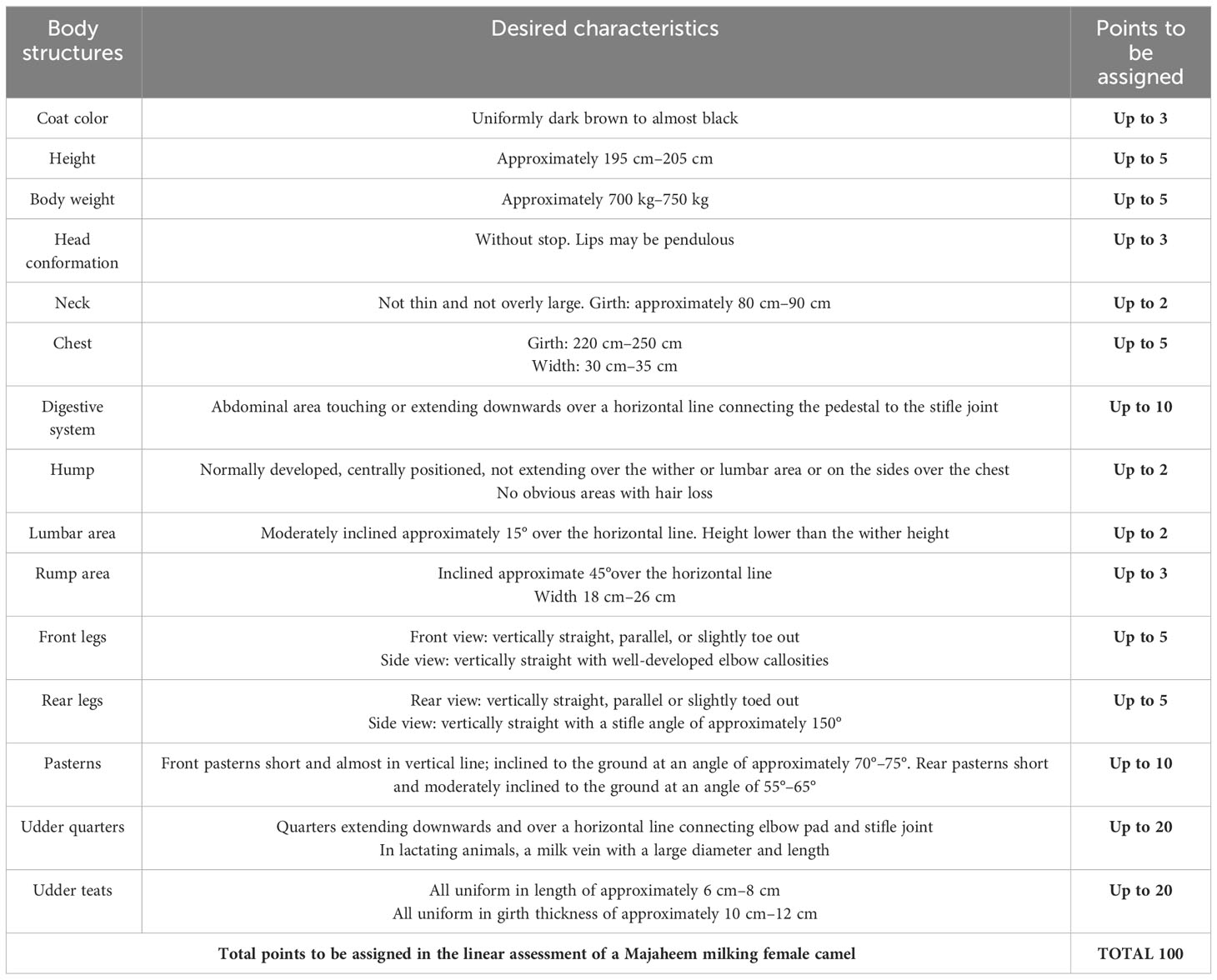
Table 1 Linear traits to be evaluated and scored during an assessment of an adult female (first and second calvers) camel of the Majaheem breed.
Coat, height, and weight assessment
The Majaheem camels are characterized by their coat, which should display a uniform color ranging from dark brown to a very dark brown, almost black shade. This coat color is a distinctive trait of the breed. The Majaheem breed is known for its tall and heavy build. Fully grown females, aged over 6 years, are expected to have a body weight of approximately 700 kg or more, with a typical wither height of approximately 195 cm–205 cm (Figure 1A).
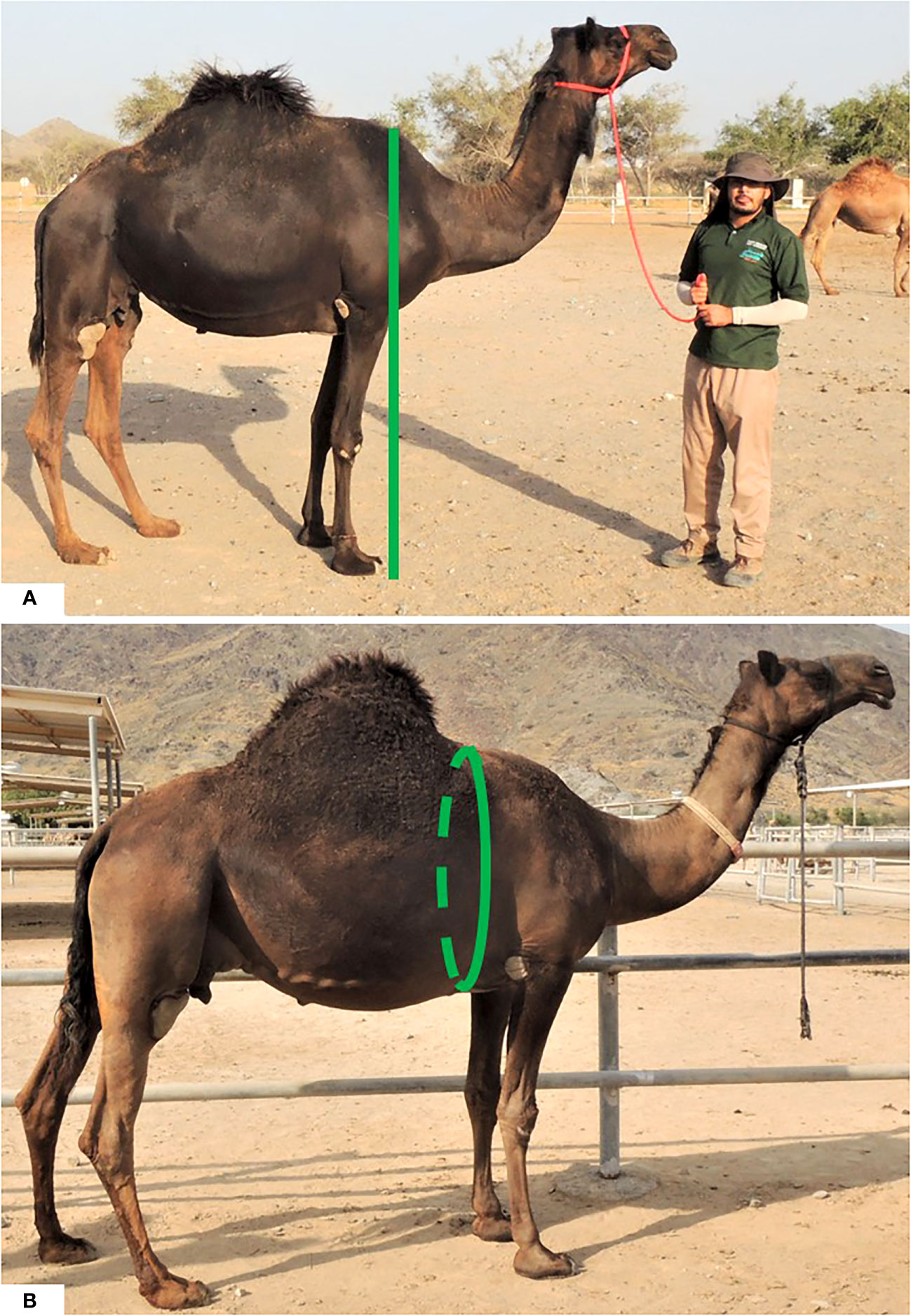
Figure 1 Correct breed standard weight, coloration, conformation, and height: (A) adult non-lactating Majaheem female, approx. 10 years old, weight: 698 kg bw, wither height: 197 cm (green line). Correct chest circumference: (B) adult Majaheem female: chest circumference 245 cm. The green line represents where the girth should be measured: from the front of the hump passing behind the pedestal. Acceptable measures approximately 220-250 cm.
Head assessment
The heads of Majaheem camels are characterized by pointed ears, along with large drooping upper lips and often pendulous lower lips (Figure 2A). Ideally, the camels should not exhibit a deep stop, which is a depression between the skull and the nasal bones that is commonly observed in many Indian/Pakistani camel breeds (Figure 2B). In addition, they should not have overly neat heads with short lips similar to those seen in racing camel breeds (Figure 2C). In terms of jaw structure, prognatism, that is, longer lower jaw (Figure 2D), or enognatism, that is, shorter lower jaw (Figure 2E) and also wry face (Figure 2F) should be considered unfavorable traits and be penalized for being a genetic fault (Fowler, 2011).
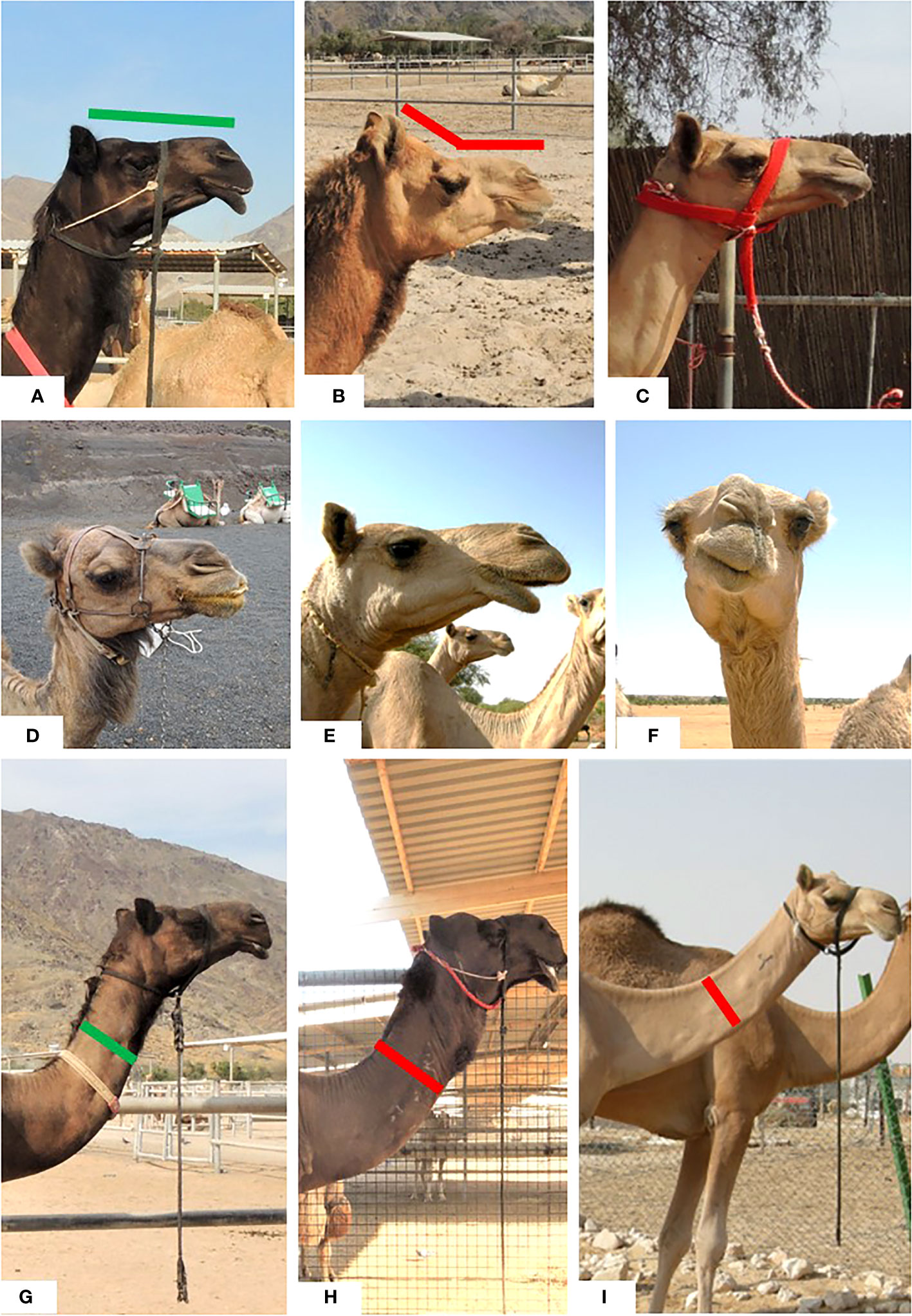
Figure 2 Head assessment of adult females: (A) Majaheem breed with correct head profile (green line), (B) Pakistani breed with pronounced stop (red lines), (C) racing camel, (D) camel with overshot mandible: prognathism (Spain), (E) camel with undershot mandible (Kenya), (F) camel with congenital malformation: a facial deformity known as “wry face” (Sudan). Necks assessment of adult camels: (G) Majaheem female, (H) Majaheem male, (I) racing female camel. The green line represents the area for measurement, acceptable neck girth: approximately 80-90 cm.
Neck assessment
The neck of female Majaheem camels should ideally be feminine in appearance, that is, it should be moderately thick (Figure 2G) and not, as observed in male camels, be excessively thick and muscled (Figure 2H). This characteristic is considered a sign of hormonal balance and is associated with better reproductive performance (Bosman and Scholtz, 2010). However, the neck should also not be overly lean (Figure 2I) as this suggests a possible genetic influence from the camel racing breed, which is known to have poor milk production.
Chest assessment
The chest area of the Majaheem camels holds significant importance as it encompasses various organs that directly influence the health, vitality, and milk productivity of the animal. Although chest girth is considered important (Figure 1B), it is essential to focus more on the correct conformation rather than just the size. An adequate width of the chest (Figure 3A) is desirable. Camels with a small chest width (Figure 3B) should be penalized during the evaluation. Furthermore, in the case of camels with a very small chest width (Figure 3C), it is necessary to check for evidence of brushing elbow/pedestal. If such faults are present, then they should be taken into consideration and the animal penalized accordingly. These assessments and considerations regarding the chest area are crucial for ensuring superior milk productivity and overall wellbeing in the Majaheem camels.
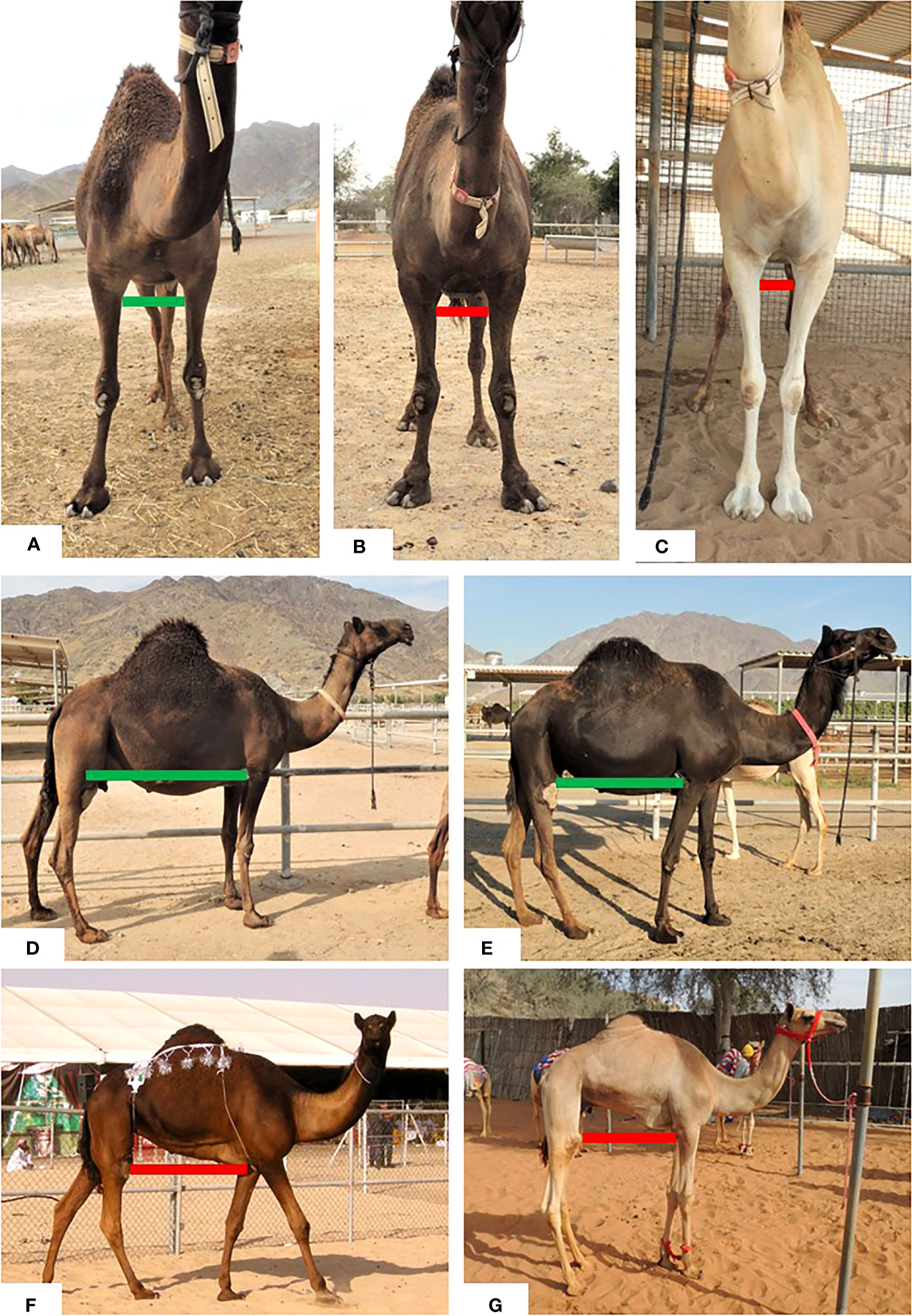
Figure 3 Chest size assessment of adult females: (A) Majaheem with optimal chest size (green line), (B) Majaheem with adequately developed chest size (green line), (C) racing female with narrow chest size (red line). Chest width measured from the inside surface between the top of the front legs, approximately 30-35 cm. Digestive system size assessment of adult females: (D) Majaheem with well-developed abdominal area (green line), (E) Majaheem with adequately developed abdominal area (green line), (F) Majaheem with insufficiently developed abdominal area (red line), (G) racing camel with training induced hypotrophy of abdominal area (red line).
Digestive system assessment (or body depth)
This is an evaluation of the abdominal size of the camel. High milk production in livestock necessitates the ingestion and processing of a large quantity of fodder, which in turn requires a spacious digestive system. Research in lactating stalled camels revealed that they required a dry matter intake of approximately 1.73 kg per 100 kg of live weight and an additional daily intake of 5 kg of concentrate (Hashi and Kamoun, 1995). Research conducted in cattle has shown that animals with a larger abdominal girth tend to have a significantly higher milk yield (Sieber et al., 1988). In cattle, those with a short horn (Benyarou et al., 2017) and/or larger abdominal girth tend to have significantly higher milk yield (Sieber et al., 1988). In camels, the assessment of abdominal capacity involves observing the extension of the abdominal areas in relation to a horizontal line drawn from the pedestal callosity to the hind legs’ stifle callosity. In camels with a large abdominal capacity, the abdominal area extends clearly below this horizontal line (Figures 3D, E). In contrast, camels with a poor abdominal capacity (Figure 3F) or that are on a special diet, such as racing camels (Figure 3G), have a much smaller abdominal area that is clearly above this horizontal line. This assessment of abdominal capacity provides valuable insights into the feeding efficiency and potential milk productivity of the Majaheem camels, ensuring the selection of individuals with optimal traits for high milk production.
Hump assessment
In camels, the size of the hump, as the organ that stores fat reserves, fluctuates based on their nutritional and production levels and overall health. Owing to this variability in size and shape, the hump cannot be considered a reliable tool for evaluating milk traits or determining the genetic purity of a specific camel breed. However, the hump size can still provide important information about a camel. Ideally, the hump should be of average size and should not extend over the wither or the lumbar area (Figures 4A, B). A small hump (Figure 4C) should be carefully evaluated as it may indicate the presence of chronic metabolic problems, diseases such as trypanosomosis, or a genetic influence from racing camel breeds. A significantly large hump also requires careful evaluation as it may be a result of obesity caused by excessive feeding or a potential hormonal imbalance that can lead to delayed or failed reproductive cycles (MaChado Pfeifer et al., 2021; Nazhat et al., 2021) A large hump can also be associated with reduced milk production due to udder pathologies. When examining a very large hump, particular attention should also be given to the presence of alopecic areas on the hump and rump (Figures 4D, E). These hairless areas are caused by the contact friction of frequent mounting of other females in the herd during estrus episodes. The presence of such areas should result in the penalization of the camel during evaluation because such frequent engagement in sexual behavior is not normal and may indicate dysfunctions in the animals’ reproductive cycle.
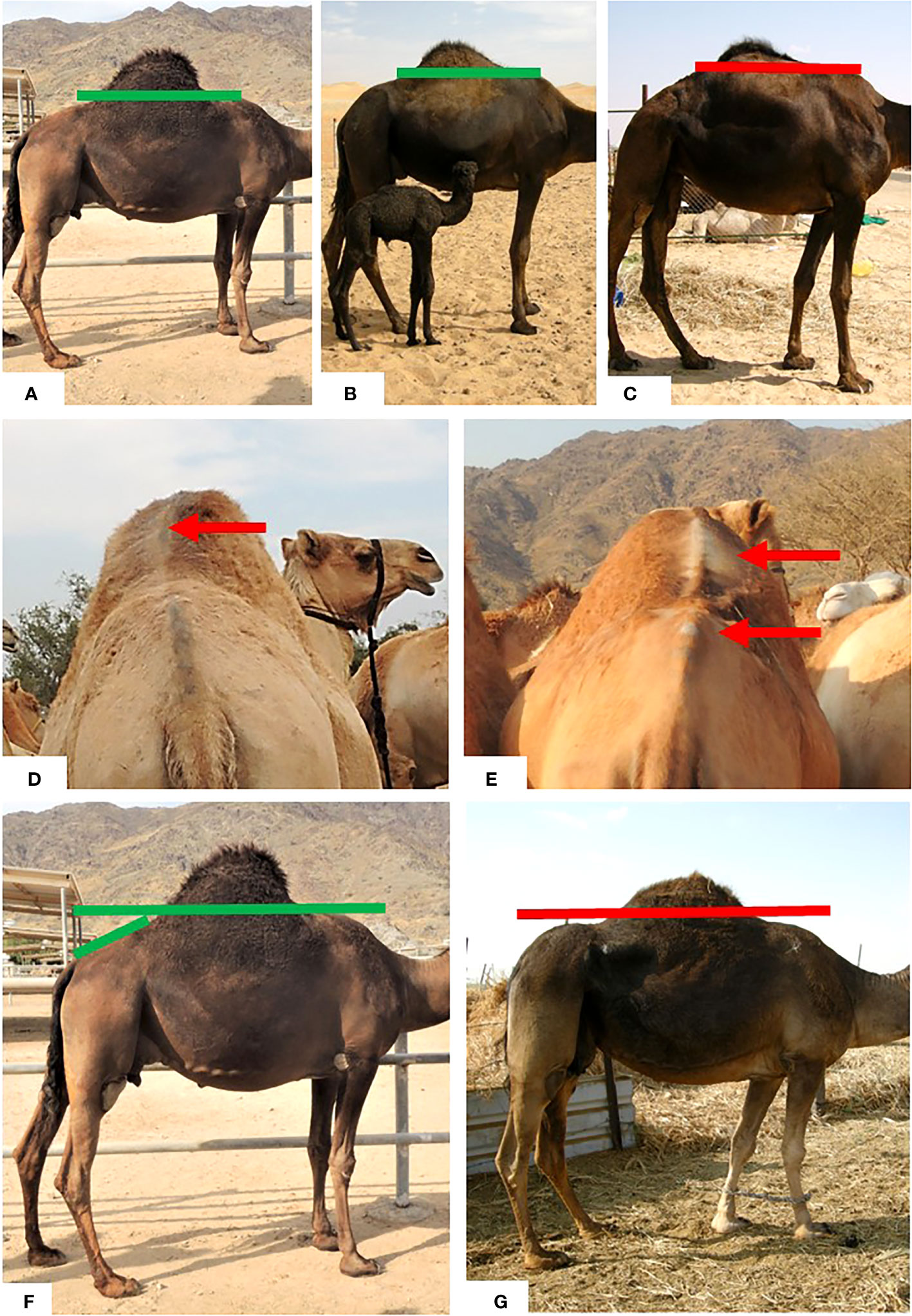
Figure 4 Hump assessment of adult females: (A) Majaheem with adequately developed hump, (B) Majaheem female with acceptable (lactation induced) smaller hump, (C) Majaheem female with insufficiently developed hump, (D, E) local UAE breed females with excessively developed humps and alopecic areas (red arrows) caused by overly frequent mountings by herd females attracted by the overly frequent hormonal signals of oestrus: a symptom of reproductive dysfunction. Lumbar area assessment: (F) Majaheem female with correct height and inclination of lumbar area: approx. 15 degrees over horizontal line, (green lines), (G) Majaheem female with incorrect lumbar height: same as wither height and lumbar area inclination (red line).
Lumbar area assessment
The vertebral column of a dromedary exhibits a slightly kyphotic curvature (Smuts Malie and Bezuidenhout, 1987). The lumbar area should reflect such conformation by having a moderately inclined angle of approximately 15°. This angle is measured as the inclination between a horizontal line drawn over the lumbar vertebrae and a line drawn horizontally from the withers (Figure 4F). In addition, the height of the lumbar area must not be the same as that of the withers but lower (Figure 4G).
Rump area assessment
The conformation of the rump plays an important role in facilitating easy delivery, reducing dystocia occurrences, and ensuring the efficient drainage of post-calving fluids. The slope of the rump should follow the lumbar area inclination, with the ischial tuberosities or pin bones positioned well below the hip bones. In addition, the rump should have an appropriate width. Ideally the rump angle should be approximately 45° in relation to the horizontal line (Figure 5A), with an adequate width of approximately 18 cm–26 cm (Figure 5B). A narrow rump (Figure 5C) should be judged unfavorably as a narrow birth canal may facilitate dystocia, particularly in immature females (Purohit, 2012).
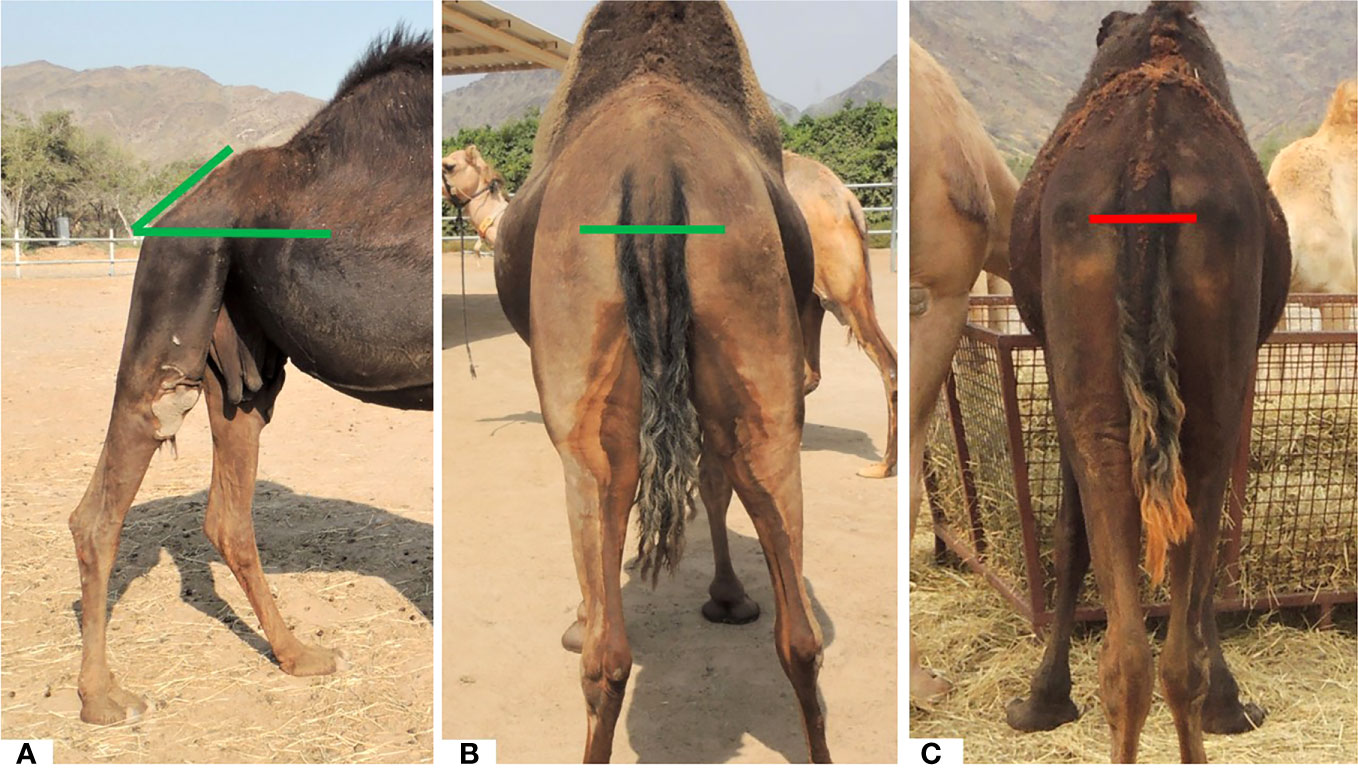
Figure 5 Rump area assessment: (A) Majaheem female with correct rump area inclination: approx. 45 degrees angle over horizontal line from iliac crest or hip bones to the ischial tuberosity or pin bone (green line), (B) Majaheem female with well-developed rump width: horizontal distance between the two ischial tuberosities or pin bones (green line), (C) Majaheem female with narrow rump width (red line).
Front legs assessment
The forequarters of a camel bear a significant portion of its weight (Kadim et al., 2008), and, therefore, it is crucial to assess the soundness of the animal’s front legs during the evaluation. Both the anterior (front) and lateral (side) views of the front legs should be examined. From the anterior view, the front legs should be vertically straight and parallel to each other (Figure 6A). Any deviation from the vertical alignment, such as “brushing knees” or “carpus valgus” (Figure 6B), should be regarded as a significant fault and result in an appropriate penalization. From the side view, the front legs should also appear equally vertical and straight (Figure 6C). The presence of “undershot knees” (Figure 6D), that is, the knees appearing to be set back from the vertical alignment, should also be regarded as a significant fault and result in appropriate penalization.
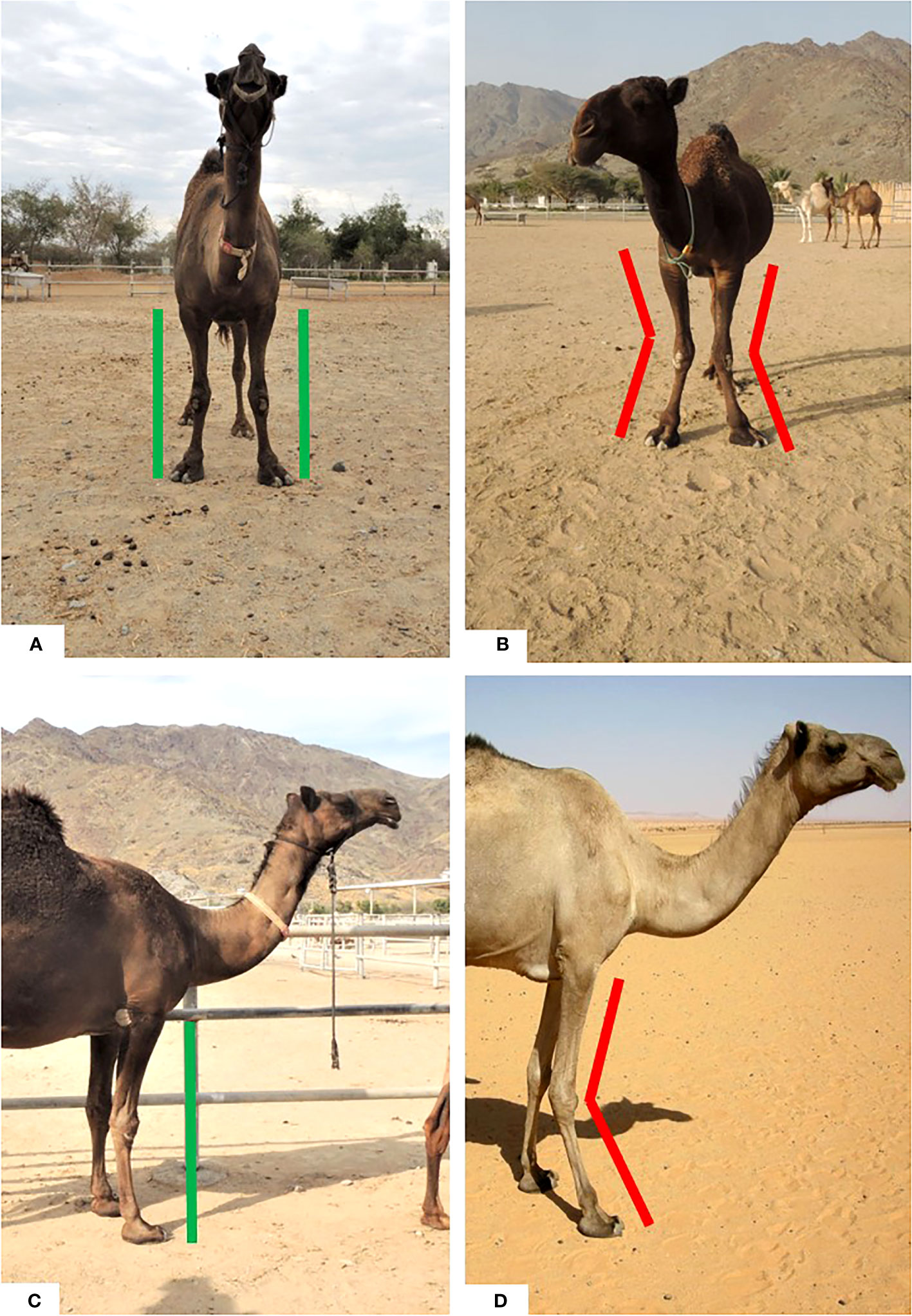
Figure 6 Front legs assessment (front view): (A) Majaheem female with correct front legs (green line), (B) Majaheem female with incorrect front legs: “brushing knees” or “carpus valgus (red lines). Front legs assessment (side view): (C) Majaheem female with correct front legs (green line), (D) local Sudan breed with incorrect front legs: “undershot knees” (red lines).
Rear legs assessment
A correct rear leg structure is crucial for camel fluid locomotion. When evaluating the animals’ rear legs, it is important to consider both the rear and side views. On the rear view, the back legs of a camel should be vertically straight (Figure 7A) or slightly toed out and preferably not too close to each other (Figure 7B). Moderate closeness of the hocks, that is, the animal being “cow-hocked” or having “tarsus valgus” (Figure 7C), is acceptable, but excessive closeness (Figure 7D) should be penalized. On the side view, the rear legs should appear vertically straight, forming an approximate 150° hock angle (Figure 7E). Rear legs that are flexed too much under the body or sickled-hocked (Figure 7F), and legs that are excessively extended posteriorly or “camped out” (Figure 7G), should be penalized. Overall, the rear legs of a camel should exhibit proper alignment and angulation, without excessive deviations or abnormalities that could hinder fluid locomotion.

Figure 7 Rear legs assessment (rear view): (A) Majaheem female with perfectly spaced rear legs (green line), (B) Majaheem female with acceptable narrow spaced rear legs (green lines), (C) Majaheem female moderately “cow-hocked” (tarsus valgus) (red lines), (D) local UAE breed female excessively “cow-hocked” (red lines). Rear legs assessment (side view): (E) Majaheem female with correct rear legs and hock angle (approx. 150 degrees over vertical line) (green lines), (F) Majaheem male with incorrect rear legs: sickled-hocked (red lines), (G) Canary Island breed female with incorrect rear legs: “camped out” (red lines).
Proximal pastern angle
Camels have evolved in a desert environment in which they need to cover large distances to find scattered food sources. This natural adaptation to long-distance walking is important, even in camels that have been selected for milk production. The camels of the Majaheem breed are heavy animals, and it is important that their foot structure is correctly built. Specifically, the proximal pasterns (first phalanx) should be of the correct size and at the correct angle in relation to the rest of the foot structure. The proximal pasterns should be approximately 7 cm–9 cm long and have a steep angle to the ground of approximately 70°–75° in the forelimbs, but the angle in the hindlimbs should be less pronounced (Figures 8A, D). Excessively long pasterns with a shallow angle to the ground are inconducive to an efficient walking gait. Such structural abnormalities can predispose the development of splayed fetlocks, a severe angular deformity leading to fetlock joint inflammation (Figures 8B, E). In cases in which there is complete pastern hyperextension, meaning that the whole fetlock joint rests on the ground (Figures 8C, F), the camel’s movement is severely compromised. The camels exhibiting such severe presentations should be culled so that these detrimental traits are not perpetuated, whereas camels with mild presentations should be severely penalized in breeding and livestock show events.
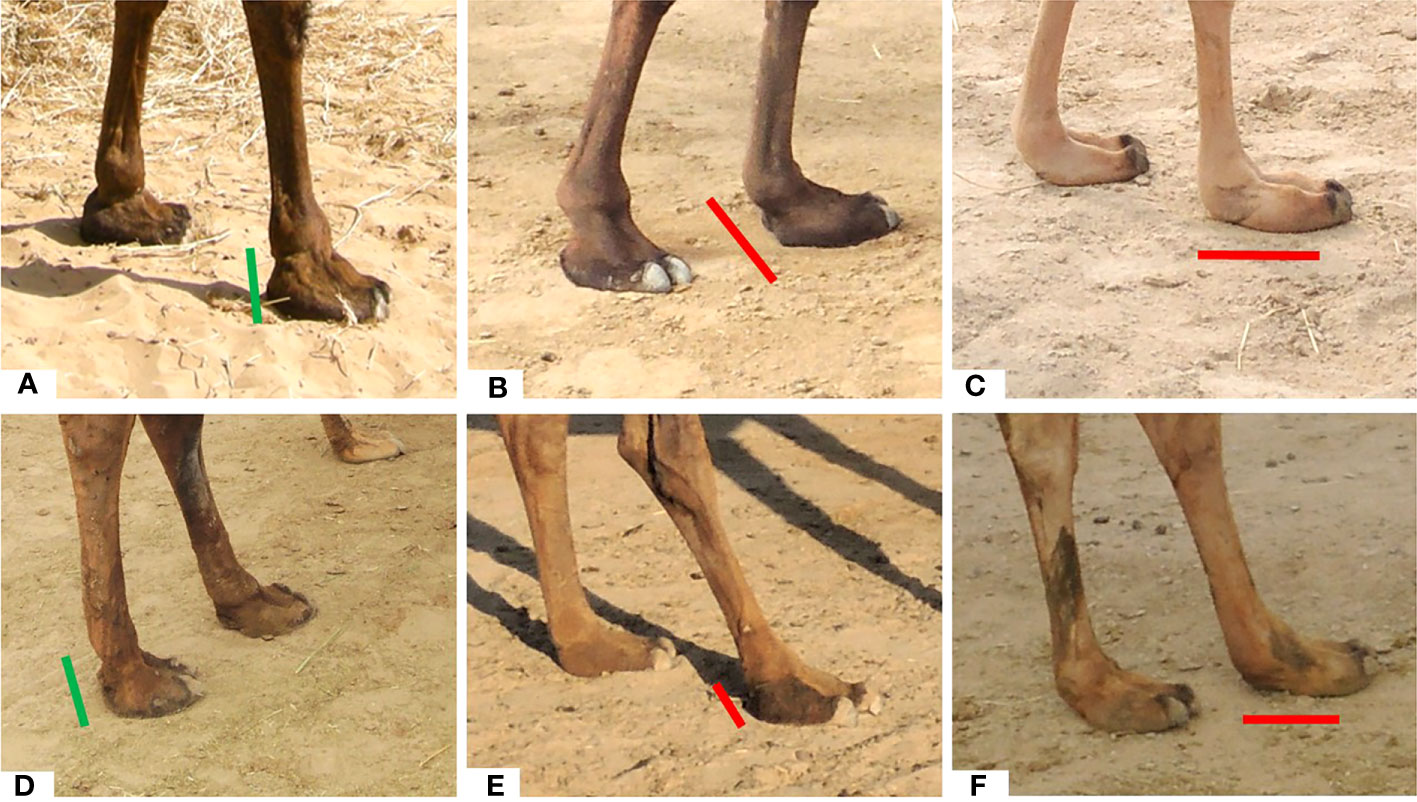
Figure 8 Front legs proximal pastern angle assessment: (A) Majaheem female with correct pastern size and angle (approx. 70-75 degrees over the ground (green line), (B) Majaheem female with overly long and inclined pasterns (red line), (C) local UAE breed female with complete collapse of the fetlock joint and pastern laying directly on the ground (red line). Rear legs proximal pastern angle assessment: (D) Majaheem female with correct pastern size and angle (approx. 55-65 degrees over the ground (green line), (E) Majaheem female with slightly excessive inclination of pasterns (red line), (F) local UAE breed female with complete collapse of the fetlock joint and pastern laying directly on the ground (red line).
Udder quarter assessment
Evaluating the mammary region is crucial in the selection of high-performing milking animals in any livestock species. However, when comparing the udders of camels with those of Holstein–Friesian cattle, we found that there are significant anatomical differences that would make it unrealistic to apply the linear assessment of the mammary system used for cattle to camels. Another barrier to the easy assessment of camel udders is their inguinal topography and the reluctance of camels to submit to prolonged manipulations and measurements of their udder area. To overcome these challenges, it is suggested that the visual evaluation of a camel’s udder should focus on two easily assessable parameters: udder depth and udder floor position. This simplified approach takes into account the unique anatomical characteristics of the camel’s udder and the practical constraints associated with udder evaluation in this species. The udder depth is assessed by comparing the downward extension of the udder toward a horizontal line drawn between the elbow callosity and the hind leg’s stifle joint. In a well-developed udder with good depth, the udder will reach and sometimes extend over this line (Figure 9A). In contrast, poorly developed udders with insufficient depth will remain clearly above this horizontal line (Figures 9B, C). The evaluation of the udder floor follows the same principle; however, it is important to note that camels are multipurpose livestock animals and, in contrast to cattle, have not undergone intensive selection for milking conformation. As a result, udder quarters in camels may not be homogeneously developed or symmetrical, and instead, two udder conformations are commonly observed: one in which the front quarters are more developed than the rear quarters and another in which the rear quarters are more developed than the front quarters. In the first conformation, the front quarters of a well-developed udder reach and extend downward over the elbow–stifle line (Figure 10A). Conversely, the front quarters of a poorly developed udder will remain clearly above the elbow–stifle line (Figures 10B, C), indicating inadequate udder development in the front quarters. In the case of udders with more developed rear quarters, the assessment is reversed. The rear quarters of well-developed udders extend downward over the elbow–stifle line (Figure 11A), whereas those of less-developed udders remain above the elbow–stifle line (Figures 11B, C). Asymmetry of the udder quarters should not be penalized unless it is extreme. In this regard, it is also important to note that the rear quarters of a camel produce more milk than the front quarters (Eisa & Hassabo, 2009; Musaad et al., 2017; Kumar et al., 2023); therefore, rear-quarters asymmetry, that is, in which the rear quarters are larger than the front quarters, should not be considered a fault. Another factor to consider when assessing a camel’s milking capacity is the size and development of the milk vein or subcutaneous abdominal vein as there is a relationship between a large diameter of the milk vein and abundant milk production (Eisa et al., 2010; Braun and Forster, 2012; Gracner et al., 2015; Berger et al., 2016; Kumar et al., 2023). In lactating camels, a large and long milk vein is considered a positive attribute (Figure 12A), whereas a poorly developed or barely visible milk vein should be viewed as a negative attribute (Figure 12B).
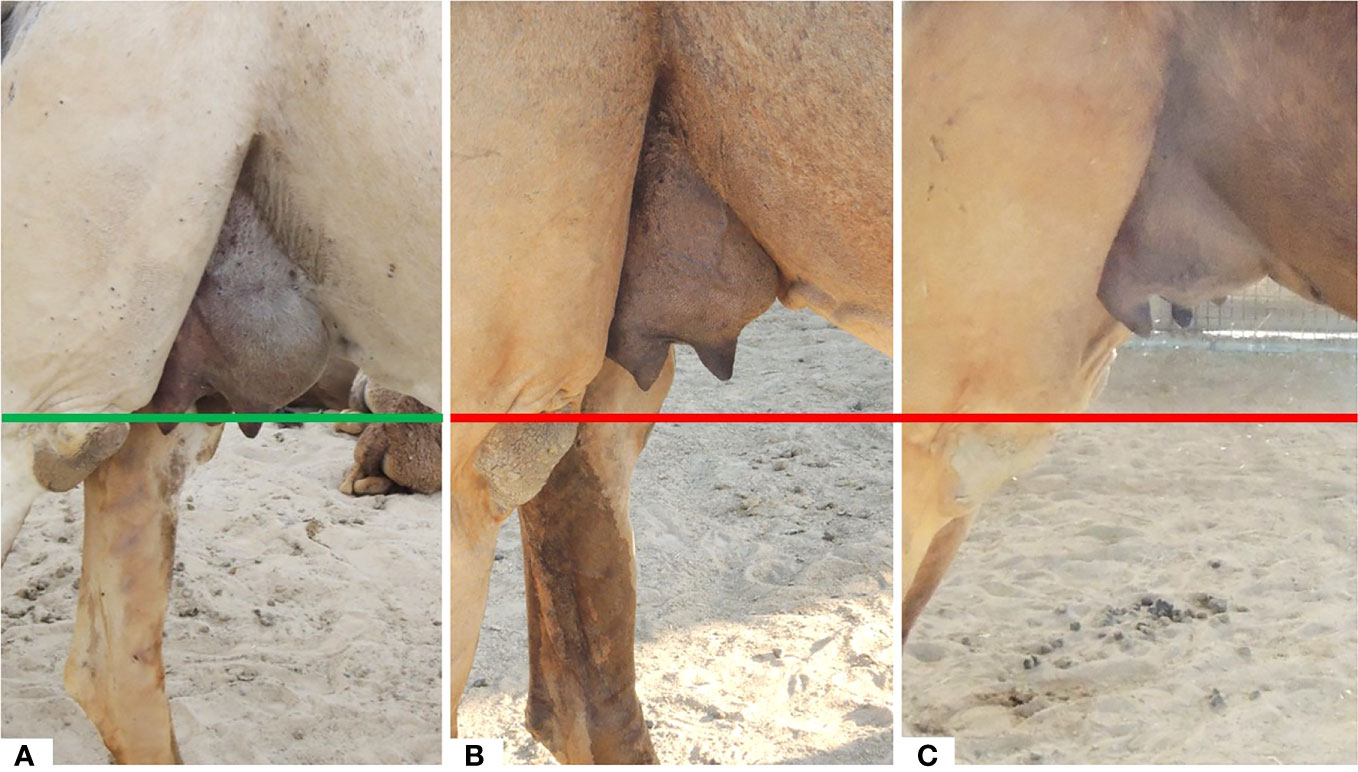
Figure 9 Udder quarters assessment: udder with symmetric quarters: (A) local UAE breed with very developed udder extending downward over the elbow–stifle line (green line), (B) local UAE breed with sufficiently developed udder but not extending over the elbow–stifle line (red line), (C) local UAE breed with insufficiently developed udder very far from the elbow–stifle line (red line).
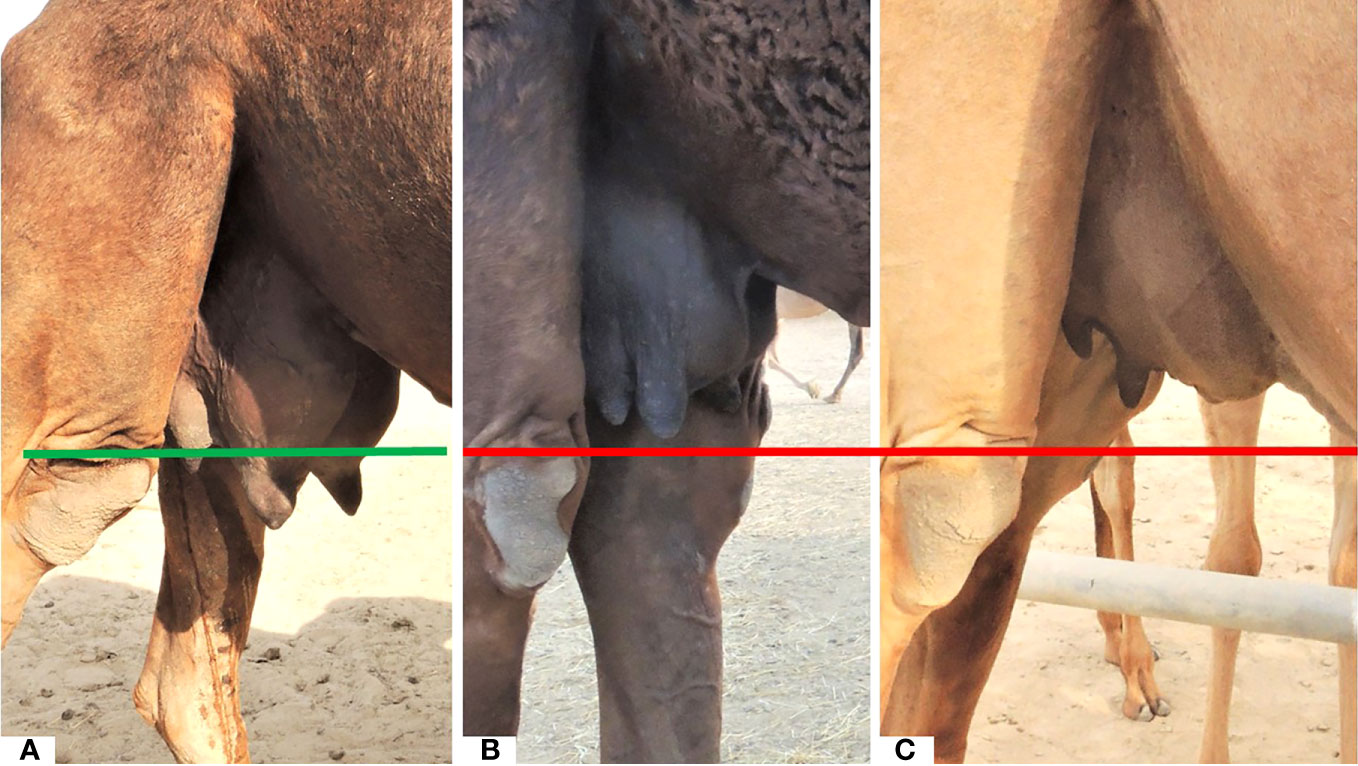
Figure 10 Udder quarters assessment: udder with asymmetric quarters: more developed front quarters: (A) Majaheem camel with very developed udder front quarters extending downward over the elbow–stifle line (green line), (B) Majaheem camel with sufficiently developed udder front quarters but not extending over the elbow–stifle line (red line), (C) local UAE breed with insufficiently developed udder front quarters: very distant from the elbow–stifle line (red line).
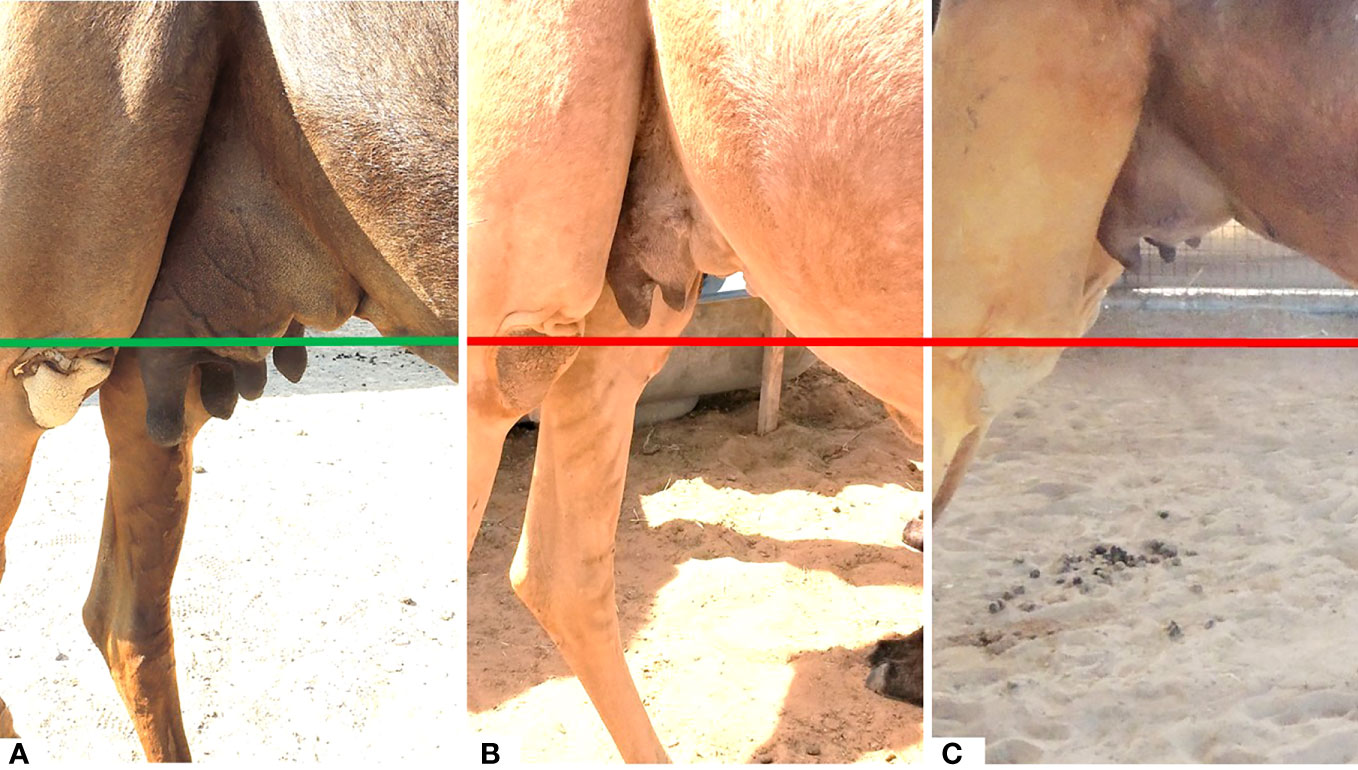
Figure 11 Udder quarters assessment: udder with asymmetric quarters: more developed rear quarters: (A) Majaheem camel with very developed udder rear quarters extending downward over the elbow–stifle line (green line), (B) local UAE breed with sufficiently developed udder rear quarters but not extending over the elbow–stifle line, (red line), (C) local UAE breed with insufficiently developed udder rear quarters: very distant from the elbow–stifle line (red line).
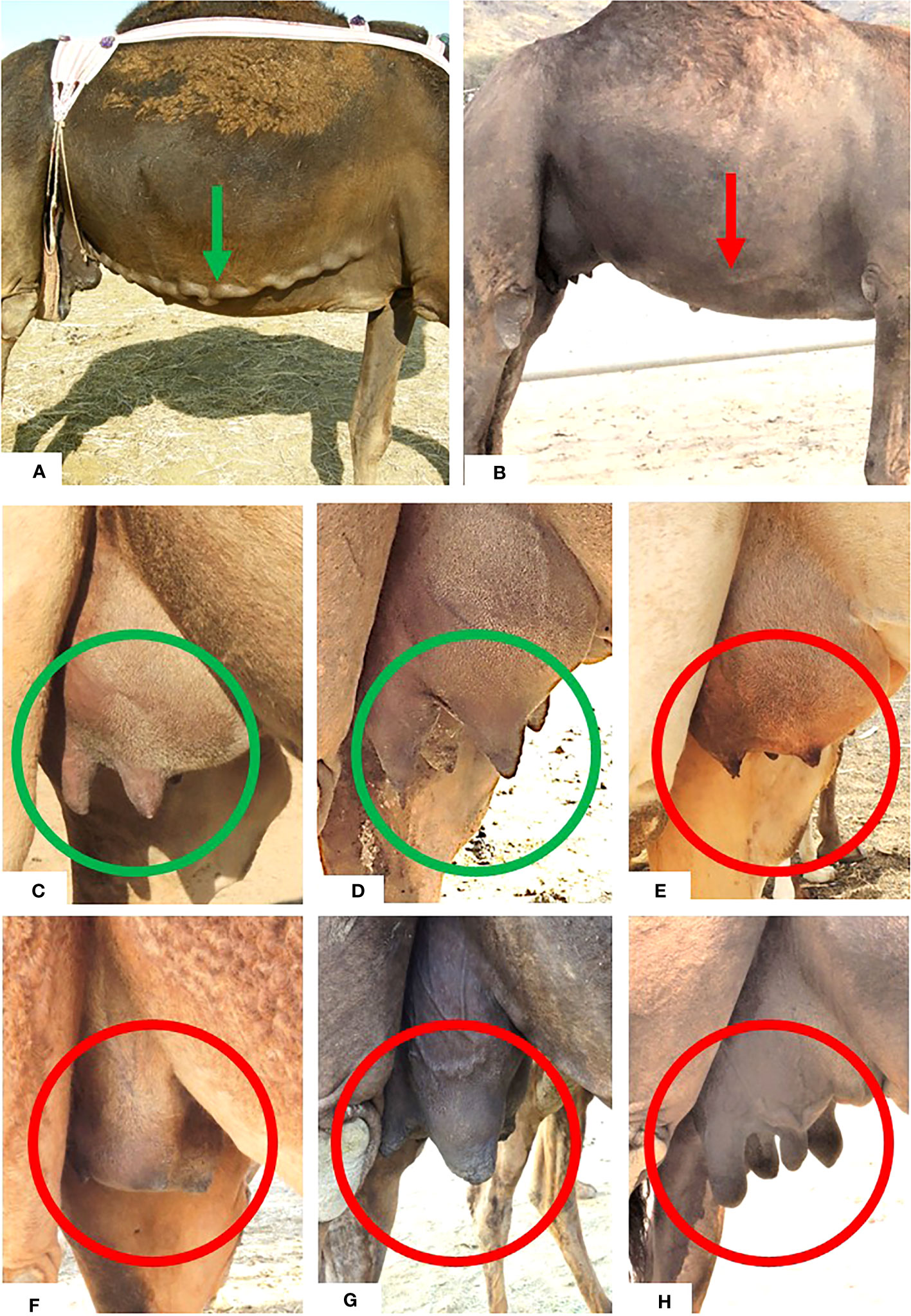
Figure 12 Milk vein assessment: (A) Majaheem lactating camel with very developed milk vein: subcutaneous abdominal vein (green arrow), (B) local UAE lactating camel with insufficiently developed milk vein (red arrow). Udder teat assessment: (C) local UAE lactating camel with uniformly developed teats of adequate size and length (green circle), (D) Majaheem lactating camel with uniformly developed teats although of excessive size (green circle), (E, F) local UAE lactating camels with teats of insufficient length (red circle), (G, H) Majaheem lactating camels with asymmetric and grossly oversized teats (red circle).
Udder teats assessment
Udder teats are an important characteristic, particularly due to the increasing use of automatic machine milking in camel farms. Therefore, it is essential to evaluate teat symmetry, length, and thickness. The ideal teats measurements have been identified to be approximately 6 cm–8 cm in length and 10 cm–12 cm in girth (Figures 12C, D) (Ayadi et al., 2016). However, it is important to note that significant variations in teat symmetry, length, and girth are very commonly observed. These variations often manifest either as inadequate teat length (Figures 12E, F) or excessive length, girth, and asymmetry (Figures 12G, H). Moderate teat size variation may be tolerated; however, extreme conformation (Figure 13A) should be penalized as it poses a serious obstacle to the efficient automatic machine milking of camels (Figure 13B).
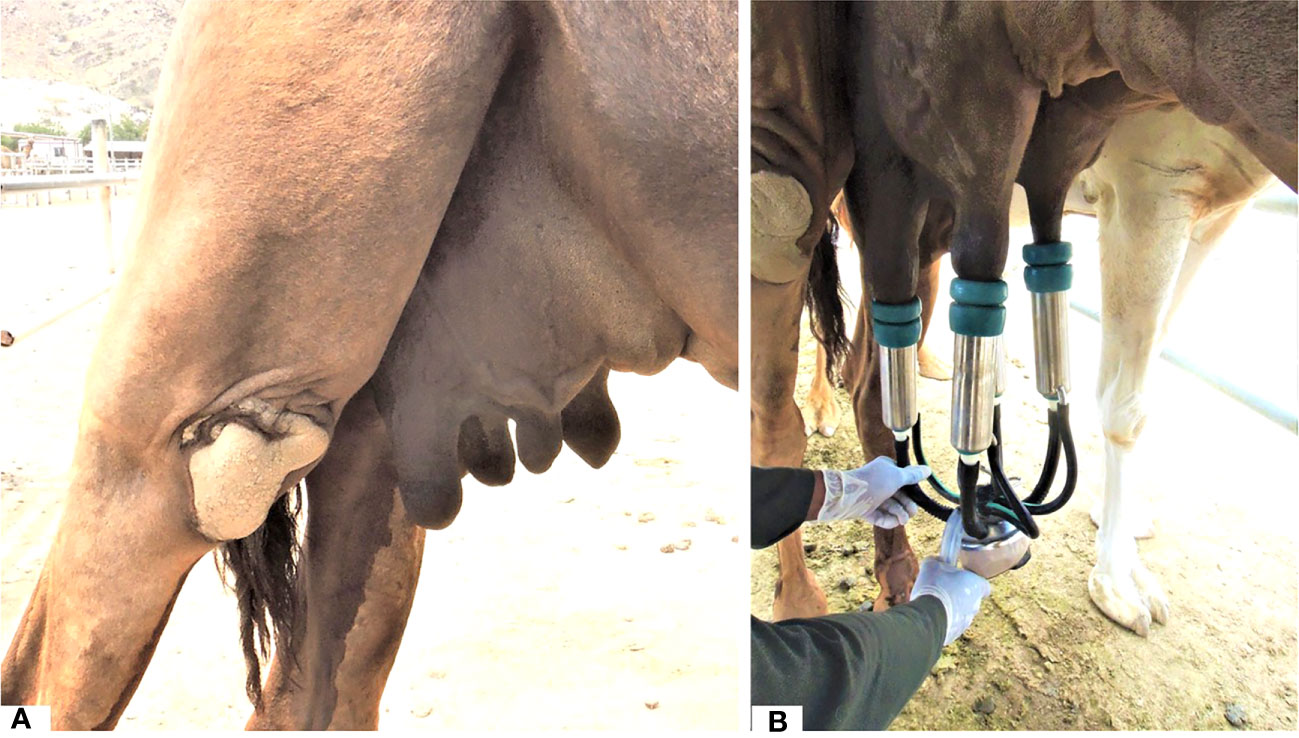
Figure 13 Abnormal udder: (A) udder of Majaheem lactating camel with asymmetric and oversized teats, (B) difficulties of applying machine milking to such type of udder.
Conclusions
The effectiveness of employing a linear-type assessment in the evaluation of dairy cattle breeds has been extensively demonstrated and is now commonly utilized as a practical tool for enhancing the selection of milk-producing livestock on a global scale. A linear-type assessment of Majaheem milking camels that relies on easily measured parameters, rather than variable and subjective personal opinions, will enhance and speed up the selection of Majaheem camels toward a more modern and efficient camel milk breed, which is also better adapted to automated machine milking. Furthermore, the use of a linear assessment will facilitate the detection of camels exhibiting skeletal malformations or unsound udder conformations. The importance of eliminating such conditions from the Majaheem breeding herds cannot be overstated as such conformation faults negatively influence the milking capacity and performance of the affected camels. Incorrect anatomical conformations are also likely to be inheritable and can therefore seriously undermine efforts to implement a successful selection plan for camels of the Majaheem breed. More importantly, morphological malformation negatively impacts the welfare of the affected camels, shortening their productive life span and causing pain and distress.
Data availability statement
The original contributions presented in the study are included in the article/supplementary material. Further inquiries can be directed to the corresponding author.
Ethics statement
Ethical approval was not required for the studies involving animals in accordance with the local legislation and institutional requirements because only images were obtained from camels visualized in the article. Camels were bred in a normal farm. No samples of any kind were collected from the camels nor was any husbandry practice carried out. Written informed consent was obtained from the owners for the participation of their animals in this study. Written informed consent was obtained from the individual(s) for the publication of any potentially identifiable images or data included in this article.
Author contributions
MD: Conceptualization, Data curation, Formal Analysis, Investigation, Methodology, Visualization, Writing – original draft. MN: Writing – review and editing. BB: Writing – review and editing, Funding acquisition. UR: Data curation, Writing – review and editing.
Funding
The authors declare that no financial support was received for the research, authorship, and/or publication of this article.
Acknowledgments
The authors wish to thank the Crown Prince of Fujairah Emirate, HRH Sheikh Mohammed bin Hamad Al-Sharqi, for offering us his research facilities and for his continuous encouragement and also Bulaida Farms staff for helping in the collection of images. We also extend grateful thanks to Dr. Tanya Frances Braithwaite for correcting and revising the English text.
Conflict of interest
All authors were employed by Bulaida Farms.
Publisher’s note
All claims expressed in this article are solely those of the authors and do not necessarily represent those of their affiliated organizations, or those of the publisher, the editors and the reviewers. Any product that may be evaluated in this article, or claim that may be made by its manufacturer, is not guaranteed or endorsed by the publisher.
References
Abdallah H. R., Faye B. (2012). Phenotypic classification of Saudi Arabian camel (Camelus dromedarius) by their body measurements. Emir. J. Food Agric. 24 (3), 272–280.
Abdallah H., Faye B. (2013). Typology of camel farming system in Saudi Arabia. Emir. J. Food Agric. 25 (4), 250–260. doi: 10.9755/ejfa.v25i4.15491
Alaskar H., Alaqeely R., Alhajeri B. H., Alhaddad H. (2021). The enigma of camel-types: localities, utilities, names, and breed statuses. J. Camelid Sci. 14 (1), 22–34.
Alaskar H., Alhajeri B. H., Almathen F., Alhaddad H. (2020). Genetic diversity and population structure of dromedary camel-types. J. Hered 111 (4), 405–413. doi: 10.1093/jhered/esaa016
Alhadrami G. A., Faye B. (2016). Animals that Produce Dairy Foods: Camel. Reference Module in Food Sciences. Elsevier, pp. 1–12. doi: 10.1016/B978-0-08-100596-5.00620-X
Al-Atiyat R. M., Suliman G., AlSuhaibani E., El-Waziry A., Al-Owaimer A., Basmaeil S. (2016). The differentiation of camel breeds based on meat measurements using discriminant analysis. Trop. Anim. Health Prod. 48 (5), 871–878. doi: 10.1007/s11250-015-0990-5
Al-Hazmi M., Ghandour A., Elgohar M. (1994). A study of the biometry of some breeds of arabian camel (Camelus dromedarius) in Saudi Arabia. J. King Saud Univ. Sci. 6, 87–99.
Anonymous (2013). A useful guide to Linear Assessment (Holstein UK). Available at: https://www.holstein-uk.org/media/legacyhw/Breeding%20for%20HW/Breeding-Linear-Assessment.pdf.
Anonymous (2018). Linear descriptive traits (Holstein Association USA, Inc: USA). Available at: https://www.holsteinusa.com/pdf/print_material/linear_traits.pdf.
Anonymous (2022). “Appendix 1 of Section 5 of the ICAR Guidelines - The standard trait definition for Dairy Cattle,” in ICAR the global standard for livestock data. (Netherlands) Available at: https://www.icar.org/Guidelines/05-Conformation-recording-Appendix-1.pdf.
Ayadi M., Aljumaah R. S., Samara E. M., Faye B., Caja G. A. (2016). A proposal of linear assessment scheme for the udder of dairy camels (Camelus dromedarius L.). Trop. Anim. Health Prod 48 (5), 927–933. doi: 10.1007/s11250-016-1051-4
Benyarou M., AmeurAmeur A., Benhamadi M., Bouhandasse A., Labbaci M., Gaouar S. B. S. (2017). Contribution to the study of the physicochemical characteristics of Bovine Milk in the Tlemcen region. Genet. Biodiversity J. Gen Biodiv. J. 1 (2), 42–47. doi: 10.46325/gabj.v1i2.95
Berger H., Lietzau M., Tichy A., Herzog K. (2016). Investigations of mammary and uterine blood flow in relation to milk yield, postpartum disease, and pregnancy result in dairy cows. Theriogenology 86 (8), 1906–1912. doi: 10.1016/j.theriogenology.2016.06.008
Bosman D. J., Scholtz M. M. (2010). “Selecting cattle for functional efficiency,” in Beef breeding in South Africa, 2nd edition. Ed. Scholtz M. M. (Pretoria: Agricultural Research Council (ARC), 33–52.
Braun U., Forster E. (2012). B-mode and colour Doppler sonographic examination of the milk vein and musculophrenic vein in dry cows and cows with a milk yield of 10 and 20 kg. Acta Vet. Scand. 54, 15. doi: 10.1186/1751-0147-54-15
Breulmann M., Boer B., Wernery U., Wernery R., El-Shaer H., Alhadrami G., et al. (2007). The camel, from tradition to modern times (Doha (Qatar: Unesco Doha Publ). Available at: https://unesdoc.unesco.org/ark:/48223/pf0000224033.
Cherifi Y. A., Gaouar S. B. S., Moussi N., TabetAoul N., Saïdi-Mehtar N. (2013). Study of camelina biodiversity in southwestern of Algeria. J. Life Sci. 7 (4), 416–427.
Derradji H., Naima B., Youcef A. C., Yakhlef H., Bouhadad R., Fodil A., et al. (2015) Genetic diversity and relationships in saharan local breeds of Camelus dromedarius as inferred by microsatellite markers. J. Camel Pract. Res 22, 1–9. doi: 10.5958/2277-8934.2015.00001.6
Dich I., Abdelbari H., Fardeheb L., Dich S., Gaouar S. B. S. (2022). Characterization of the fineness of she-camel’s wool in the Wilaya of Nâama and El Bayadh. Genet. Biodiv. J. 6 (1), 181–195. doi: 10.46325/gabj.v6i1.209
Dioli M. (2014) Pictorial guide to traditional management, husbandry and diseases of the one-humpedCamel. Available at: https://www.google.com/books/edition/Pictorial_Guide_to_Traditional_Managemen/sZAbOhTtBgkC?hl=en&gbpv=0.
Dioli M. (2016). Towards a rational camel breed judging: a proposed standard of a camel (Camelus dromedarius) milk breed. J. Camel Pract. Res. 23, 1–12. doi: 10.5958/2277-8934.2016.00001.1
Eisa M. O., Hassabo A. A. (2009). Variations in milk yield and composition between fore and rear udder-halves in she-camel (camelus dromedaries). Pak. J. Nutr. 8 (12), 1868–1872. doi: 10.3923/pjn.2009.1868.1872.
Eisa M. O., Ishag I. A., Abu-Nikhaila A. M. (2010). A note on the relationships between udder morphometric and milk yield of Lahween camel (Camelus dromedarius). Livest. Res. Rural. Dev. 22(188).
El-Hanafy A. A., Saad Y. M., Alkarim S. A., Almehdar H. A., Alzahrani F. M., Almatry M. A., et al. (2023). Yield and composition variations of the milk from different camel breeds in Saudi Arabia. Sci 5, 2. doi: 10.3390/sci5010002
Evans J. O., Simpkins S. P., Aitkins D. (1995). “Camel keeping in Kenya,” in Range management handbook of Kenya (Kenya; :Ministry of Agriculture Livestock Development and Marketing/GTZ).
Fadlelmoula A. A., Mudarris M. S., Hariri M. S. (2015). Phenotypic classification based on body measurements and body features of some saudi camel types (Camelus dromedarius). J. Camel Pract. Res. 22 (2), 265–270. doi: 10.5958/2277-8934.2015.00044.2
FAOSTAT (2020) Food and agriculture organizationFood and agriculture data (Rome). Available at: http://www.fao.org/faostat/ (Accessed 28 March 2023).
Faye B. (2020). How many large camelids in the world? A synthetic analysis of the world camel demographic changes. Pastoralism 10 (1), 25. doi: 10.1186/s13570-020-00176-z
Faye B., Abdallah H., Almathen F., Harzallah B., Al-Mutairi S. (2011). “Camel biodiversity, camel phenotypes in the kingdom of Saudi Arabia,” in Camel breeding, protection and improvement center, UTF/SAU/021/sau (KSA: FAO). Available at: https://publications.cirad.fr/une_notice.php?dk=562659.
Gaouar S. B. S., Ciani E. (2023). An overview of camel biodiversity and genetics. Biol. Life Sci. Forum 22, 15. doi: 10.3390/blsf2023022015
Gherissi D. E., Monaco D., Bouzebda Z., Bouzebda F. A., Gaouar S. B. S., Ciani E. (2020). Camel herds’ reproductive performance in Algeria: Objectives and thresholds in extreme arid conditions. J. Saudi Soc Agric. Sci. 19 (7), 482–491. doi: 10.1016/j.jssas.2020.09.002
Gracner D., Gilligan G., Garvey N., Moreira L., Harvey P., Tierney A., et al. (2015). Correlation between the milk vein internal diameter surface and milk yield in Simmental cows. Turkish J. Vet. Anim. Sci. 39, 741–744. doi: 10.3906/vet-1505-106
Hashi A. M., Kamoun M. (1995). “Feed requirements of the camel,” in Elevage et alimentation du dromadaire. Ed. Tisseran d J.-L. (Zaragoza: CIHEAM), 71–80. Available at: http://om.ciheam.org/article.php?IDPDF=95605343.
Hjort A. (1988). Camels in development. Sustainable production in african drylands (Uppsala: Scandinavian Institute of African Studies).
Holl H., Isaza R., Mohamoud Y., Ahmed A., Almathen F., Cherifi Y., et al. (2017). A frameshift mutation in KIT is associated with white spotting in the arabian camel. Genes 8, 102. doi: 10.3390/genes8030102
James A. (2020) Brief history of camel racing: dubai’s NASCAR of the desert. Available at: https://farewellalarms.com/a-brief-history-of-camel-racing-dubais-nascar-of-the-desert-f5401ddafe1f.
Kadim I. T., Mahgoub O., Purchas R. W. (2008). A review of the growth, and of the carcass and meat quality characteristics of the one-humped camel (Camelus dromedaries). Meat Sci. 80 (3), 555–569. doi: 10.1016/j.meatsci.2008.02.010
Khalaf S. (1999). amel racing in the gulf. Notes on the evolution of a traditional cultural sport. Anthropos 94 (1/3), 85–106.
Kumar M., Nehara M., Prakash V., Pannu U., Jyotsana B. (2023). Udder, teat, and milk vein measurements of Indian dromedary camel and its relationship with milkability traits. Trop. Anim. Health Prod 55, 36. doi: 10.1007/s11250-023-03457-y
MaChado Pfeifer L. F., Walvonvitis R. B., Nogueira E. (2021). Relationship between body condition score index and fertility in beef cows subjected to timed artificial insemination. Livest. Sci. 248, 104482. doi: 10.1016/j.livsci.2021.104482
Meghelli I., Kaouadji Z., Yilmaz O., Cemal İ., Karaca O., Gaouar S. B. S. (2020). Morphometric characterization and estimating body weight of two Algerian camel breeds using morphometric measurements. Trop. Anim. Health Prod., 52, 1–8. doi: 10.1007/s11250-020-02204-x
Musa B. E., Salim M. A., Abu Samra M. T. (2000). Omani camel calves in a traditional management system Revue Élev. Méd. vét. Pays Trop. 53 (2), 209–212.
Musaad A., Ayadi M., Khalil A., Aljumaah R. S., Faye B. (2017). Udder and teat shape and the relationship with milk yield in camels (Camelus dromedarius). Sch. J. Agric. Vet. Sci. 4 (10), 418–423.
Mwacharo J. M., Okeyo A. M., Kamande G. K., Rege J. E. O. (2006). The small East African shorthorn zebu cows in Kenya. I: Linear body measurements. Trop. Anim. Health Prod 38, 65–74. doi: 10.1007/s11250-006-4266-y
Nagy P., Juhasz J. (2016). Review of present knowledge on machine milking and intensive milk production in dromedary camels and future challenges. Trop. Anim. Health Prod 48 (5), 915–926. doi: 10.1007/s11250-016-1036-3
Nagy P., Skidmore J. A., Juhasz J. (2022). Intensification of camel farming and milk production with special emphasis on animal health, welfare, and the biotechnology of reproduction. Anim. Front. 12 (4), 35–45. doi: 10.1093/af/vfac043
Nagy P., Thomas S., Marko O., Juhasz J. (2013). Milk production, raw milk quality and fertility of dromedary camels (Camelus dromedarius) under intensive management. Acta Vet. Hung 61, 71–84. doi: 10.1556/avet.2012.051
Nazhat S., Aziz A., Zabuli J., Rahmati S. (2021). Importance of body condition scoring in reproductive performance of dairy cows. A Review. Open J. Vet. Med. 11, 272–288. doi: 10.4236/ojvm.2021.117018
Purohit G. (2012). Dystocia in camelids: The causes and approaches of management. Open J. Anim. Sci. 2, 99–105. doi: 10.4236/ojas.2012.22013
Schwartz H. J., Dioli M. (1992). The one-humped camel in Eastern Africa. A pictorial guide to diseases, health care and management (Berlin: Margraf Scientific Book).
Sieber M., Freeman A. E., Kelley D. H. (1988). Relationships between body measurements, body weight, and productivity in Holstein dairy cows. J. Dairy Sci. 71 (12), 3437–3445. doi: 10.3168/jds.S0022-0302(88)79949-X
Smuts Malie M. S., Bezuidenhout A. J. (1987). Anatomy of the dromedary (Oxford Oxfordshire New York: Clarendon Press; Oxford University Press).
Stamschror J., Seykora T., Hansen L. (2000). Judging dairy cattle (USA: University of Minnesota). Available at: https://extension.umaine.edu/4h/wp-content/uploads/sites/38/2010/08/judging_dairy_cattle.pdf.
World Holstein Friesian Federation (2005) International type evaluation of dairy cattle. Available at: https://whff.info//wp-content/uploads/2023/02/EN-International-type-evaluation-of-dairy-cattle-06-2005.pdf.
Keywords: Camelus dromedarius, Majaheem breed, conformation, linear scorecard, Holstein Friesian
Citation: Dioli M, Nasef M, Braithwaite BJ and Rehman U (2023) A proposed simplified scorecard for the linear descriptive evaluation of dairy characters of female camels (Camelus dromedarius) of the Majaheem breed. Front. Anim. Sci. 4:1270230. doi: 10.3389/fanim.2023.1270230
Received: 31 July 2023; Accepted: 08 September 2023;
Published: 10 October 2023.
Edited by:
Semir Bechir Suheil Gaouar, University of Tlemcen, AlgeriaReviewed by:
Djallel Eddine Gherissi, University of Souk Ahras, AlgeriaMohamed Ahmed M’Beirick, Institut Supérieur d’Enseignement Technologique de Rosso-Mauritanie, Mauritania
Copyright © 2023 Dioli, Nasef, Braithwaite and Rehman. This is an open-access article distributed under the terms of the Creative Commons Attribution License (CC BY). The use, distribution or reproduction in other forums is permitted, provided the original author(s) and the copyright owner(s) are credited and that the original publication in this journal is cited, in accordance with accepted academic practice. No use, distribution or reproduction is permitted which does not comply with these terms.
*Correspondence: Maurizio Dioli, camel4ever@fastemail.us
†ORCID: Maurizio Dioli, orcid.org/0000-0001-9025-7456
 Maurizio Dioli
Maurizio Dioli Mostafa Nasef
Mostafa Nasef